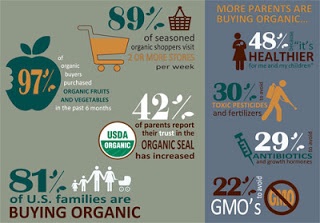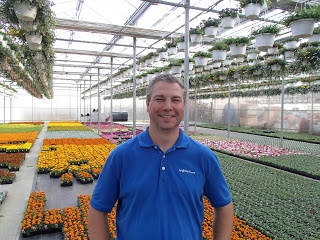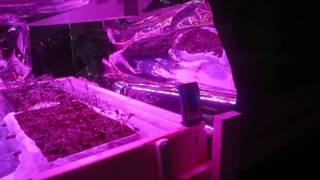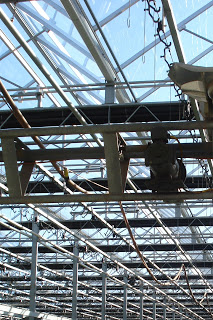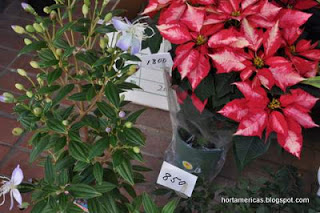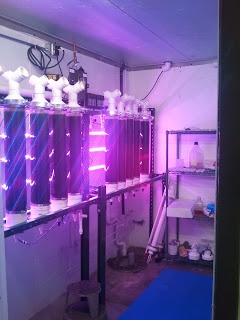
U.S. university floriculture professors and extension
specialists have collaborated to bring the floriculture industry an extensive
and thorough information resource.
it is one anyone involved in floriculture should check out. How good is the
website? This summer the American Society for Horticultural Science presented
the website’s developers with its Extension Educational Materials Award.
 |
| The American Society for Horticultural Science presented the developers of the e-GRO website with its Extension Educational Materials Award |
The two-year-old e-GRO: Electronic Grower Resources
Online website was the brainchild of Brian Krug, extension greenhouse and
horticulture specialist at University of New Hampshire, Brian Whipker, extension
floriculture specialist at North Carolina State University, Roberto Lopez,
floriculture extension specialist at Purdue University, and Nora Catlin, floriculture
specialist at Cornell Cooperative Extension of Suffolk County.
travelling together,” said Brian Krug. “We were discussing how difficult it was
to prepare an extension newsletter. Roberto had the idea of doing a newsletter
collectively. We invited Nora Catlin, who is a plant pathologist, to join us in
creating the e-GRO Alert newsletter. The newsletter is funded by the American Floral Endowment.
newsletter we decided to do a seasonal weekly newsletter based on what we saw
going on in commercial greenhouses. The primary focus is what is happening in
greenhouses during the spring season beginning at the end of January through
May. Sometimes we prepare more than one newsletter during the week depending on
the issues that are occurring in commercial greenhouses.”
a “heads up”
Krug said that although there is a tentative schedule as
to what is going to be written about during a specific week, the topic and
author can change depending on what growers may be dealing with. The
newsletters cover a variety of grower-related issues including disease and pest
management and environmental, physiological and nutritional disorders being
observed in commercial greenhouses.
plant growth regulators written by Brian Whipker, but that will depend on what
he has seen occurring in growers’ greenhouses,” Krug said. “Ours is a very
reactionary industry. With the Alert newsletter we are trying to give the
growers a heads up as to something that they might already have in their
greenhouses or may be something that is coming their way.”
to include Cornell University entomologist Dan Gilrein, University of Georgia
floriculture professor Paul Thomas and Virginia Tech horticulture professor and
Virginia Cooperative Extension specialist for greenhouse crops Joyce Latimer.
Joining the group in 2014 will be Kristin Getter, who is the floriculture
outreach specialist at Michigan State University.
authors’ respective states,” Krug said. “We have subscribers in 48 states and
over a dozen different countries.”
greenhouse basics
Another part of the website is e-GRO University. This
section was developed by Krug, Whipker, Lopez, Kansas State University
floriculture professor Kim Williams, Kansas State ornamental and horticultural entomologist
Ray Cloyd and Cornell University senior extension associate and plant
pathologist Margery Daughtrey. e-GRO University is the second phase of the
website which includes over 60 videos that cover the basics of greenhouse
production. The videos are divided up into five different sections: greenhouse
management, nutrition management, growth management, insects and mites, and diseases.
e-GRO University has been funded by the Gloeckner Foundation for two years.
 |
| e-GRO University provides a Greenhouse 101 curriculum that covers basic information for greenhouse management and production. |
“For e-GRO University we developed a Greenhouse 101
curriculum that provides basic information for greenhouse management and
production,” Krug said. “It is information that would be comparable to a
freshmen and sophomore college course program. Our goal was to provide an
educational resource for people who work in the industry who didn’t receive a
formal education in greenhouse production. If you are grower in a greenhouse without
the formal training or education, this program allows a person to get a handle
on some of the basics on nutrition, insects and diseases. A person can choose
to listen to any of the videos, which run 20 minutes or less. Most of the
information is basic concepts so it is not going to be changing.”
certificate program for e-GRO University.
certificate program will enable interested growers in holding themselves
accountable and will indicate that a person successively completed the
lectures. The certificate will indicate that a person successfully completed
e-GRO University. There will be five different modules and a quiz at the end of
each module. A person will be able to choose how many of the modules they want
to complete.”
by growers for new employees who don’t have any experience or limited
experience in different aspects of growing.
enables employees to be held accountable for the modules that they have
completed,” he said. “We’re hoping that employers will use this for their
employees. We wanted to offer something more for the greenhouse employees.”
by vocational teachers who have access to a greenhouse and who may need to
familiarize themselves with the basics before they and their students try to
start growing plants in the facility. This could be a continuing education
program for the teachers as well as a learning resource for the students.”
resources
Other resources available to visitors of the e-GRO
website include:
This is the newest resource being offered by the e-GRO. The series kicks off
with “Poinsettia Troubleshooting,”
a two-hour webinar on Sept. 18 that will focus on troubleshooting poinsettia
problems. Ray Cloyd will discuss key insect identification and control issues.
Brian Whipker will focus on nutrition disorder identification and management. North
Carolina State University plant pathologist Kelly Ivors will cover disease
identification and control.
completed by members of the e-GRO team in cooperation with Greenhouse Grower
magazine over the last three to four years. Krug said linking the podcasts on
e-GRO enables growers to search for the episodes they want to view.
electronic books that are available for the iPad. Krug said that Whipker plans
to continue to create new books for the library. Books currently available
include:
Floricultural Crops. This free publication was done in collaboration with Joyce
Latimer at Virginia Tech and Brian Whipker at North Carolina State University.
2. e-GRO Volume One: Poinsettia
3. e-GRO Alert Volume Two
4. e-GRO Volume Three: Primula
5. e-GRO Alert Volume Four: Sclerotinia
members felt it was worth adding to the website. John Dole, professor and head
of the Department of Horticultural Science at North Carolina State University,
partnered with American Floral Endowment to create the Floriculture InfoSearch
engine. This search engine provides convenient and comprehensive access to
floriculture literature, videos and presentations. Information is available from
scientific literature and trade and association magazines and websites. The
Floriculture InfoSearch website also contains a floriculture archive with
materials dating back to the early-1800s from AFE, North Carolina State,
scientific journals and trade publications.
For more:
Brian Krug, (603) 862-0155; brian.krug@unh.edu.
Worth, Texas; dkuack@gmail.com.
Visit our corporate website at https://hortamericas.com









